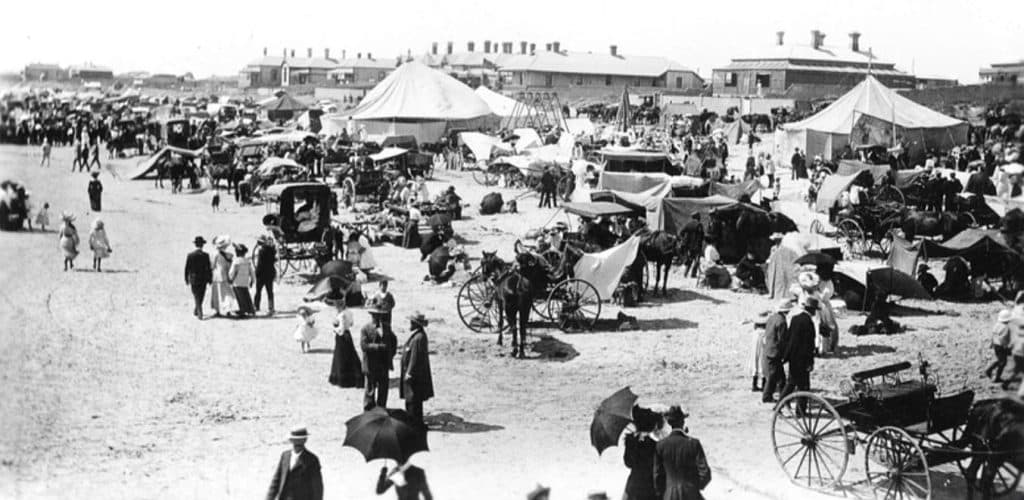Historic Henley by the sea

Prior to the arrival of Europeans, the area inland from the sand dunes between Glenelg and the Port River was a seasonal wetland the Kaurna people called Witongga.
Fed by the River Torrens (Karrawirrparri), it provided a buffet of yabbies, mussels and assorted small game. The prolific reeds were used for basket weaving and making other handy items.
From the late 1830s, the fertile land was taken up by settler’s market gardens and orchards, but further development was hampered by swamps and regular flooding from the river.
There was only limited drainage to the sea through the Port and Patawalonga rivers. The River Torrens’ current course beneath Henley Beach Road and Tapleys Hill Road to the outlet didn’t exist at the time. More on that soon.
A remnant channel, now known as Grange Lakes, that linked the River Torrens to the Port River can still be seen running from Grange Road to West Lakes.
In the early days, Henley Beach – named after England’s Henley-on-Thames – was more of a weekend retreat than a residential burb. Suburban development in the area didn’t really get started until a moderate subdivision was laid out in the late 1870s.
Getting there
The first regular public transport to Henley Beach was a double-decker, horse-drawn tram service that began operating in 1882. Initially it terminated on Seaview Road in front of the Ramsgate Hotel, but it was later extended to Grange.

Although the train from the city to Grange via Woodville was in action by 1882, it didn’t reach Henley Beach until 1894, running down Military Road from Grange to a terminal in front of the Henley Police Station’s current location.
The horse-drawn tram, which roughly followed the alignment of Henley Beach Road, was often stopped or delayed by flooding.
When trams switched to electric in 1909, an elevated viaduct was built along what’s now HMAS Australia Road, Henley Beach South, to help cross a particularly swampy area.
The train from Grange to Henley stopped running in 1957, and the trams came to a halt during the controversial shutting of all lines, except the Glenelg service, in 1958.

The square
Opening its doors in Henley Square in 1897, the Ramsgate Hotel was the area’s second pub. The Henley Hotel further south opened in 1878.
Complete with fancy parapets, the Henley Kiosk became an instant hit with beachgoers when it opened in 1911. It was built by the State Government’s tram operator, the Municipal Transport Trust (MTT), to encourage tram trips to the beach.

Over the years its tenants have included Moby Dicks Tavern, a Chinese restaurant and an RSL clubroom. In 1986 it became home to one of Henley’s most popular eateries, the Thai Orchid restaurant, though the parapets are long gone.
The square’s had several makeovers through the years, with the most recent redevelopment undertaken in 2015.
Amusements
Henley Beach Jetty was completed in 1883. A 1915 upgrade included a three-storey pavilion, described in an Advertiser article as “luxuriantly furnished” with “electric lighting installed throughout.”

There was a café on the ground floor, a music room and lounge on the next level, and a roof garden up top.
Sadly, a 1942 storm severely damaged the pavilion and it was demolished in 1945.
In 1934, an open-air, salt-water Olympic-size swimming pool was opened on the beachside of the lifesaving club’s current spot. Not only was it a popular summer hangout, it was also used for Henley High School swimming carnivals and served as a training facility for Dawn Fraser as she prepared for the 1956 Melbourne Olympics.
Over the years the pool was battered by storms until it was eventually closed and demolished in 1985. Three rescued starting blocks are cemented to the footpath south of the lifesaving club, standing as testament to this long-lost Henley icon.

Drained
Flooding of the Henley Beach hinterland – known by Europeans as the reed beds – continued to be a problem until the River Torrens was diverted and channelled from Lockleys to the sea. The Torrens Outlet at the Henley Beach South/West Beach boundary was opened in 1937, after three years of construction.
The troublesome wetlands soon drained, opening the way for extensive urban development, which boomed after World War II.
The rest, as they say, is history.


